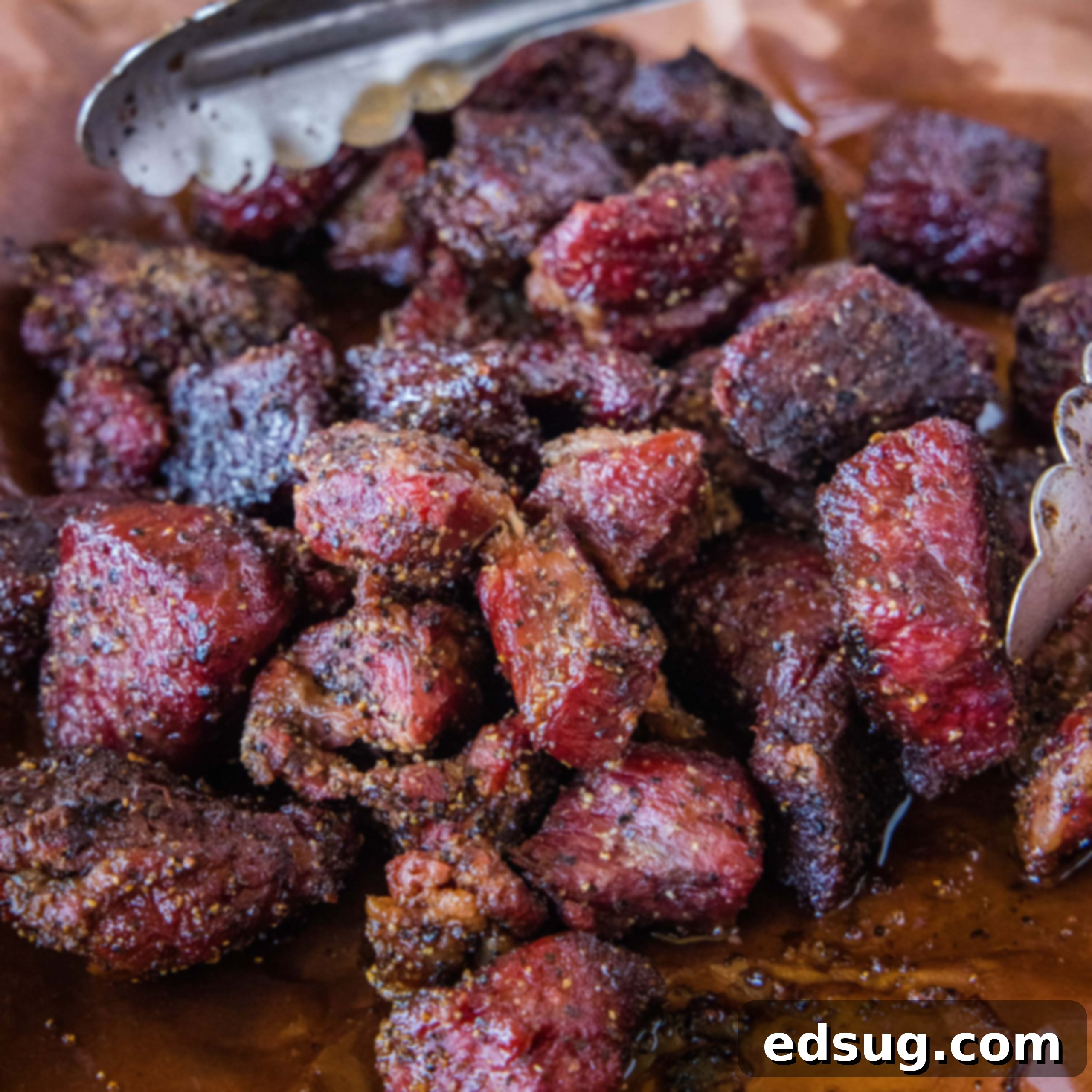Smoked Poor Man’s Burnt Ends: An Affordable & Delicious Chuck Roast Recipe
Poor Man’s Burnt Ends – do you love burnt ends, but don’t want to invest the time or money in smoking a full brisket? Use a chuck roast for a faster and more affordable version with all the same delicious flavor! This comprehensive guide will walk you through creating juicy, tender, and incredibly flavorful burnt ends right in your backyard smoker, making this classic barbecue treat accessible to every home cook.
For any barbecue aficionado, the mention of “burnt ends” conjures images of succulent, smoky, and intensely flavorful bites of meat. These coveted morsels, typically found at traditional barbecue joints, are often limited in supply and command a premium price. The reason for their rarity and high cost stems from their origin: the point of a beef brisket, a large and expensive cut of meat that requires extensive time and considerable skill to prepare properly. A full packer brisket can take anywhere from 12 to 16 hours, or even longer, to smoke to perfection, representing a significant investment of both time and money. Furthermore, mastering the art of brisket smoking takes a lot of practice to get right, which can be daunting for many home cooks.
But what if you could enjoy that same tender, juicy, and smoky goodness without the hefty price tag or the all-day, all-night commitment? Enter Poor Man’s Burnt Ends – a brilliant barbecue hack that utilizes a humble chuck roast to deliver a remarkably similar experience. This method drastically cuts down on both cooking time and overall cost, making these mouth-watering burnt ends an achievable delight for anyone with a smoker (or even an oven!). By transforming an affordable chuck roast into these bite-sized barbecue treasures, you unlock a world of rich, beefy flavor and melt-in-your-mouth texture that will impress even the most discerning barbecue enthusiasts, proving that great barbecue doesn’t always have to break the bank or consume your entire weekend.
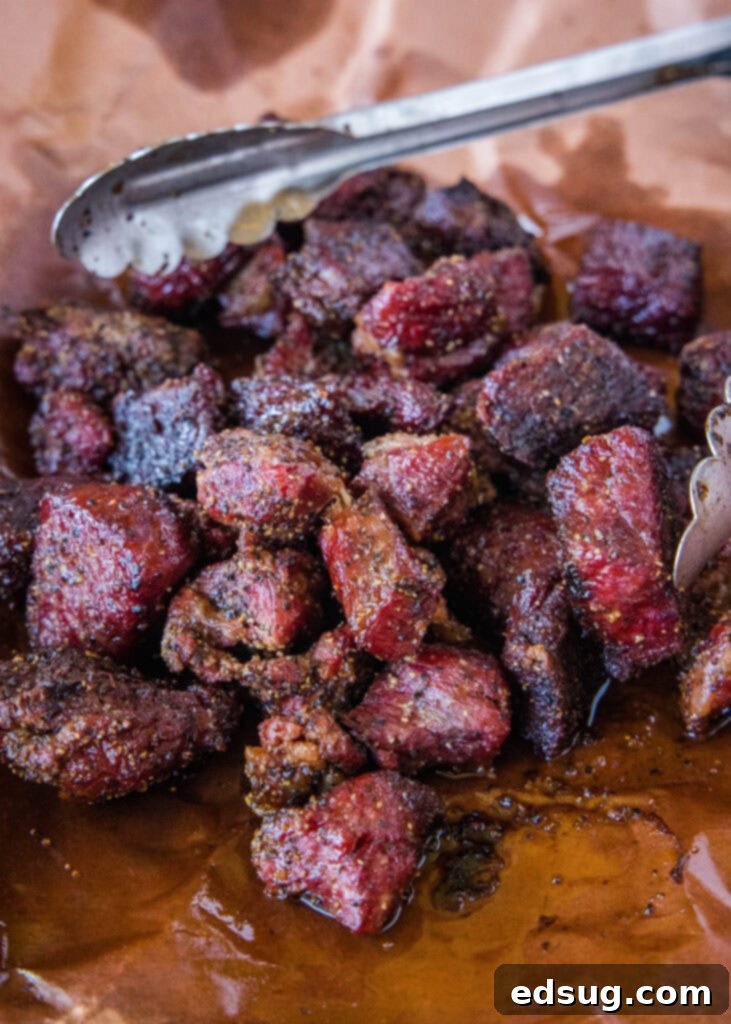
What Are Poor Man’s Burnt Ends? A Closer Look at This BBQ Hack
To truly appreciate the brilliance of Poor Man’s Burnt Ends, it helps to understand their traditional counterpart. Burnt ends classically come from the “point” or “deckle” section of a full beef brisket. This particular portion is highly marbled with fat and abundant in connective tissue, and because it’s typically thinner and cooks faster than the “flat” (the leaner part of the brisket), it develops a darker, almost charred exterior – hence the “burnt” in burnt ends. Despite this dark, crispy crust, the high fat content ensures the interior remains incredibly tender, juicy, and gelatinous once rendered down. These succulent cubes are then often tossed in barbecue sauce, creating a perfect balance of smoky, sweet, and savory flavors that are truly irresistible.
Poor Man’s Burnt Ends aim to replicate this desirable texture and flavor profile using a different, more accessible cut of beef: the chuck roast. A chuck roast, sourced from the shoulder of the cow, is renowned for its rich beefy flavor and its generous marbling, along with significant amounts of collagen and connective tissue. While not identical to brisket, when cooked low and slow for an extended period, this tough connective tissue breaks down into luxurious gelatin, yielding incredibly tender and juicy results that are strikingly similar to brisket point. The ample marbling in a good chuck roast further ensures that, even with the development of a dark, “burnt” exterior, the meat remains moist, flavorful, and incredibly satisfying.
When selecting a chuck roast for this recipe, the most important factor is to aim for a well-marbled piece of meat. Those visible streaks of fat throughout the muscle are absolutely key to achieving that signature tender and juicy bite, as they will render down and baste the meat from within. A 3-4 pound chuck roast is ideal for this recipe; it offers enough meat for a generous serving without requiring an excessively long cooking time. I’ve often found excellent, generously sized and well-marbled chuck roasts at warehouse clubs like Costco, which are perfect for this application. The flavor profile of a slow-smoked chuck roast is remarkably reminiscent of the brisket flat, but with the added benefit of being more forgiving and significantly easier to manage for a home cook who might not have years of smoking experience.

Essential Ingredients for Irresistible Poor Man’s Burnt Ends
Before you fire up your smoker, let’s gather the simple yet powerful ingredients that will transform your chuck roast into these incredible burnt ends. Each component plays a vital role in achieving that perfect balance of smoky, savory, and sweet flavors. Be sure to scroll to the bottom of the post for the FULL PRINTABLE recipe card with exact measurements.
- 3-4 pound chuck roast: As discussed, this is the star of our show. Look for a roast with abundant marbling for the best results in terms of tenderness and flavor. This cut provides the robust beef flavor and melt-in-your-mouth texture when cooked properly.
- Kosher Salt: Essential for seasoning the meat thoroughly and contributing to the formation of that delicious, crusty bark. Kosher salt’s larger granules distribute evenly and penetrate the meat effectively for deep seasoning.
- Coarse Black Pepper: A foundational component of nearly any classic barbecue rub. It adds a desirable peppery kick and plays a significant role in developing the exterior crust.
- Garlic Powder: Provides a subtle yet powerful aromatic flavor that complements beef beautifully, adding depth to the rub without overpowering the smoky notes.
- Beef Broth: This is used for spritzing the meat during the initial smoking phase. It helps to keep the surface of the chuck roast moist, which in turn encourages better smoke adhesion, promotes the formation of a rich bark, and prevents the exterior from drying out prematurely.
- Butter: This might seem like an unusual addition to a smoked meat recipe, but butter is an absolute game-changer for Poor Man’s Burnt Ends. It adds an incredible layer of richness and moisture, helping to mimic the luxurious rendered fat of traditional brisket burnt ends. Do not skip this step for maximum succulence!
- Barbecue Sauce: The glorious finishing touch! A good barbecue sauce adds tang, sweetness, and a beautiful glaze to the burnt ends. While any favorite brand will work, my Homemade Barbecue Sauce is a personal favorite for its versatility and perfectly balanced flavor profile.
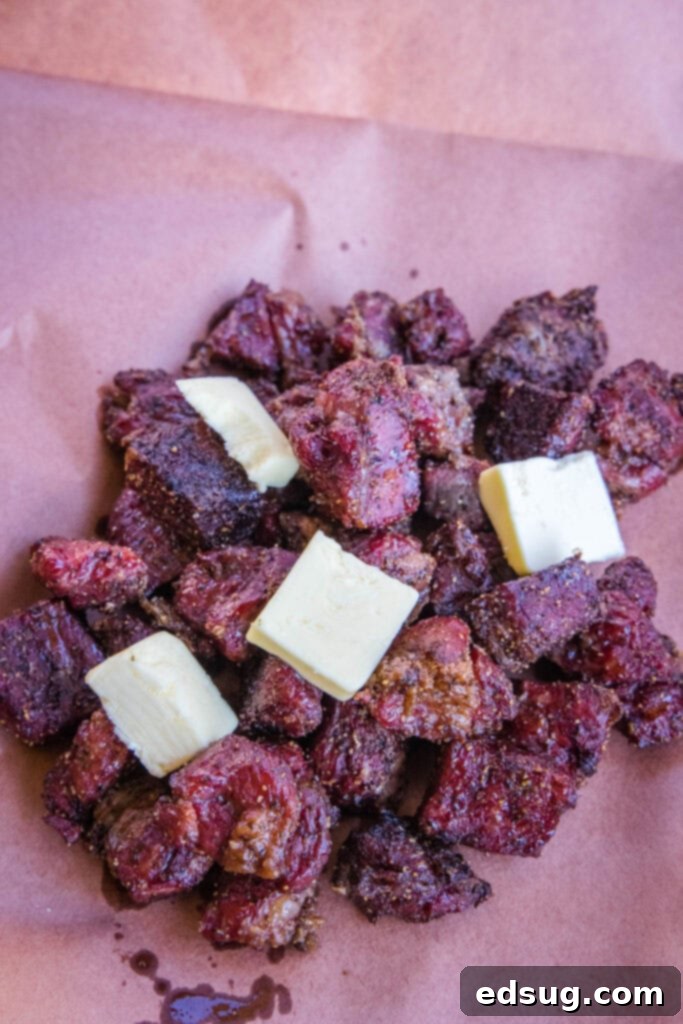
Mastering the Smoker: How To Make Perfect Poor Man’s Burnt Ends
Creating these incredible burnt ends is a surprisingly straightforward process, especially when compared to the meticulous nature of smoking a full brisket. By following these detailed steps, you’re guaranteed to achieve tender, smoky, and intensely flavorful results every single time:
- Prep The Chuck Roast. Begin by carefully cutting your 3-4 pound chuck roast into approximately 1 to 1.5-inch cubes. The goal here is uniformity; ensuring all cubes are roughly the same size is crucial for even cooking, preventing some pieces from drying out while others are still undercooked. Once cubed, liberally toss the chuck roast pieces with your chosen rub: a generous mix of kosher salt, coarse black pepper, and garlic powder. Take your time to ensure every surface of each cube is thoroughly coated for maximum flavor penetration and the best possible bark development.
- Initiate The Smoking Process. Preheat your smoker to a consistent and stable temperature of 250ºF (120ºC). Once your smoker has reached and maintained this temperature, arrange the seasoned chuck roast cubes directly on the grates. It’s important to leave sufficient space between each piece to allow for optimal smoke circulation, which is essential for developing that coveted smoky flavor and bark. Smoke the meat until it reaches an internal temperature of 175ºF (79ºC). This initial smoking phase typically takes around 2 hours, but please remember that actual cooking time can vary significantly based on factors like the specific fat content of your roast, the exact size of the meat cubes, the type of smoker used, and external ambient temperatures. Always rely on a reliable meat thermometer for accurate internal temperature readings.
- Maintain Moisture with Regular Spritzing. To prevent the beef cubes from drying out and to actively encourage a rich, flavorful bark, it’s vital to spritz them with beef broth every 30 minutes during the initial smoking period. This gentle mist of liquid helps to keep the surface of the meat moist, which in turn allows the smoke to adhere better to the meat, and aids in the formation of a robust bark without it becoming too tough or dry.
- The Crucial Wrap (The Texas Crutch). Once the internal temperature of the meat reaches 175ºF (79ºC), it’s time for the widely recognized “Texas Crutch” – wrapping the meat. Carefully remove the chuck roast cubes from the smoker and transfer them to a large sheet of heavy-duty butcher paper (which is preferred for its breathability, helping to preserve the bark’s texture) or robust aluminum foil. Before sealing the wrap, generously place a few pats (approximately 4 tablespoons total) of butter over the top of the meat. As the wrapped meat continues to cook, this butter will melt and baste the meat, adding an incredible layer of richness and moisture that significantly contributes to the final tenderness and flavor. Wrap the packets tightly to seal in the moisture.
- The Final Tenderizing Cook. Return the tightly wrapped meat packets to the smoker. Continue cooking at the same temperature of 250ºF (120ºC) for another 90 minutes or until the meat reaches an internal temperature of 205ºF (96ºC). At this stage, the meat should be incredibly tender; a probe thermometer inserted into a cube should slide in with very little resistance, much like pushing it through softened butter. This relatively high internal temperature allows the remaining collagen and connective tissue to fully break down into gelatin, ensuring that signature melt-in-your-mouth texture that defines truly great burnt ends.
- Rest, Sauce & Serve. Once your burnt ends reach the desired tenderness and temperature, remove them from the smoker. It is absolutely crucial to allow the wrapped meat to rest for at least 15 minutes. This critical resting period allows the internal juices, which have been driven to the center during cooking, to redistribute evenly throughout the entire piece of meat, resulting in a significantly more succulent and flavorful final product. After resting, carefully unwrap the cubes, transfer them to a large bowl, and toss them generously with your favorite barbecue sauce until every piece is beautifully and evenly coated. Serve these fantastic Poor Man’s Burnt Ends immediately and prepare for a truly delicious barbecue experience!
What If I Don’t Have A Smoker? Oven-Baked Burnt Ends Are Possible!
Don’t have a dedicated smoker in your backyard? No problem at all! You can still achieve wonderfully tender and flavorful Poor Man’s Burnt Ends right in your oven. The fundamental principles of low and slow cooking remain the same, ensuring that the chuck roast has ample time for its tough connective tissues to break down into delicious, succulent gelatin. While you won’t get the authentic smoke ring or the deep, complex smoky flavor that a traditional smoker imparts, you can certainly create a deeply satisfying and incredibly tasty dish.
To make these in the oven, simply follow the same recipe steps, including the initial seasoning, cooking times, and target internal temperatures as outlined for the smoker. Preheat your oven to 250ºF (120ºC). Arrange the seasoned chuck roast cubes on a wire rack set over a baking sheet. This setup allows for even air circulation around the meat, mimicking the smoker environment as much as possible and promoting even cooking. Continue to spritz the meat with beef broth every 30 minutes, just as you would in a smoker, to maintain moisture and aid in browning. Once the meat reaches 175ºF (79ºC) internal temperature, remove it, add the butter, wrap it tightly in aluminum foil (or parchment paper for a slightly softer bark), and return it to the oven until it hits 205ºF (96ºC) and is undeniably probe-tender.
To compensate for the absence of authentic smoke flavor, consider adding a dash of liquid smoke to your beef broth spritz or incorporating a generous amount of smoked paprika into your rub. These additions can impart a subtle smoky essence to the meat. For that desired crispy, “burnt” exterior, after the meat has rested, you can toss the sauced cubes into a hot cast-iron skillet for a few minutes to crisp them up, or spread them evenly on a baking sheet and place them under a preheated broiler for 3-5 minutes, watching them carefully to prevent actual burning. This final step will give you that irresistible textural contrast that burnt ends are known for.
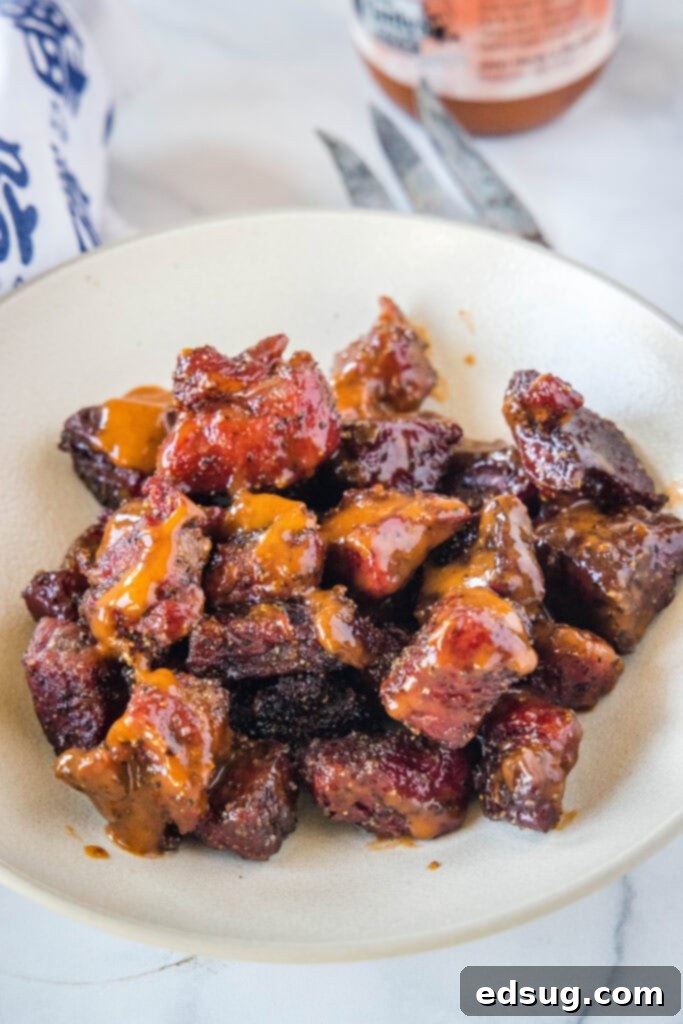
The Secret to Succulence: Why Butter Is Essential for Poor Man’s Burnt Ends
You might be wondering why butter, a seemingly unconventional ingredient in traditional barbecue, plays such a crucial role in this specific recipe. The answer lies in its ability to effectively replicate the rich, unctuous texture and deep flavor profile that are hallmarks of traditional brisket burnt ends. Brisket point, from which classic burnt ends are derived, is naturally very fatty and highly marbled throughout its structure. As it smokes for many, many hours, this internal fat slowly renders down, essentially basting the meat from within and contributing significantly to its legendary juiciness, tenderness, and its almost gelatinous, melt-in-your-mouth consistency.
While chuck roast is an excellent and highly flavorful substitute, it typically doesn’t possess the exact same fat distribution or sheer quantity of intramuscular fat as a brisket point. Adding butter during the wrapping phase helps to expertly bridge this gap. As the wrapped meat continues to cook in its foil or butcher paper packet, the butter melts and is absorbed into the chuck roast. This process effectively “bastes” the meat, providing an extra, much-needed layer of moisture and incredible richness. This infusion of butter aids dramatically in the final breakdown of any remaining tough connective tissues, resulting in a significantly more succulent, tender, and flavorful bite that remarkably closely mimics the luxurious mouthfeel of genuine brisket burnt ends. We first discovered the magic of this trick after ordering a premium brisket from Goldbelly, where the reheating instructions specifically advised adding butter – and the difference it made was astounding! Since that discovery, it has become an absolutely non-negotiable and essential step in our chuck roast burnt ends recipe.
Expert Tips for Achieving Legendary Poor Man’s Burnt Ends
To ensure your Poor Man’s Burnt Ends are nothing short of spectacular, keep these expert tips in mind. They’ll help you navigate the cooking process and achieve that perfect barbecue perfection:
- The single most important tool in your barbecue arsenal, whether you’re using a smoker or an oven, is a **reliable meat thermometer**. Cooking meat, especially low and slow, is more about reaching the correct internal temperature for optimal tenderness and food safety than strictly adhering to a predetermined timer. While the times suggested in recipes serve as a valuable guide, if you’ve ever smoked anything before, you know that the actual amount of time required can change every single time due to variables like meat thickness, fat content, ambient temperature fluctuations, and even smoker efficiency. Invest in a good instant-read thermometer like the Thermapen Mk4, which I’ve personally found to be incredibly accurate and fast for many years.
- **Do not skip the butter.** Seriously, this step is a genuine game-changer for Poor Man’s Burnt Ends. Remember, burnt ends are a decadent treat, not typically considered a health food. Their undeniable appeal comes from their inherently rich, fatty, and deeply flavorful nature. The addition of butter during the wrapping stage ensures that your chuck roast burnt ends achieve that same luscious, melt-in-your-mouth texture and added succulence that makes traditional brisket burnt ends so sought after and celebrated.
- **Prioritize selecting a highly marbled chuck roast.** The marbling – those beautiful white streaks of intramuscular fat – is what truly breaks down and renders during the long, slow cooking process. This rendering fat is directly responsible for basting the meat from within, contributing an immense amount of flavor, crucial moisture, and ultimately creating that incredibly tender and juicy bite of beef that we’re aiming for. A lean chuck roast, unfortunately, will almost certainly result in dry, tough, and disappointing burnt ends, so don’t be shy about choosing a cut with a little extra visible fat!
- **Cut your meat uniformly.** This might seem like a small detail, but unevenly sized cubes of chuck roast will invariably cook at different rates. Some smaller pieces might dry out and become tough before larger pieces are fully tender. Take the extra few minutes to cut your chuck roast into roughly 1 to 1.5-inch pieces for the most consistent and satisfying results across all your burnt ends.
- **Embrace the “stall.”** When smoking larger cuts of meat, you’ll frequently encounter a phenomenon known as the “stall,” where the internal temperature of the meat unexpectedly plateaus for an extended period. This is entirely normal, primarily caused by evaporative cooling. Wrapping the meat (the “Texas Crutch”) is an effective technique to push through this stall, expediting the cooking process and ensuring the meat continues to tenderize.
- **Do not rush the resting period.** After the meat comes off the smoker or out of the oven, it is absolutely crucial to let it rest, still wrapped, for at least 15 minutes. This critical resting period allows the internal juices, which have been driven towards the center during the cooking process, to redistribute evenly throughout the entire meat, leading to a significantly more succulent, tender, and flavorful final product.
- **Consider your wood choice for smoking.** For smoking beef, robust and flavorful woods like oak, hickory, or mesquite are excellent choices. They impart a deep, savory smoke flavor that stands up incredibly well to the richness of the chuck roast, creating a classic barbecue profile.

What Goes With Poor Man’s Burnt Ends: Perfect Pairings for Your BBQ Feast
The beauty of barbecue cuisine lies not just in the magnificent main dish, but also in the incredible array of side dishes that perfectly complement and enhance the experience. Poor Man’s Burnt Ends are no exception and pair wonderfully with classic summer sides that offer a delightful balance of flavors and textures, completing your ultimate barbecue feast. Here are a few of my favorites that will elevate your meal:
- Smoked Potatoes: These are a fantastic choice because they absorb incredible smoky flavor directly from the smoker, creating a harmonious and deeply satisfying pairing with your burnt ends. They become wonderfully tender on the inside and develop a slightly crispy exterior.
- Classic Potato Salad: Creamy, tangy, and wonderfully refreshing, a good potato salad provides a much-needed cool contrast to the rich, warm, and savory burnt ends. Its mustardy or mayonnaise-based dressing often works wonders in cutting through the richness of the meat, offering a palate cleanser.
- Best Cornbread: Whether you prefer it sweet or savory, warm, moist cornbread is absolutely perfect for soaking up any lingering barbecue sauce and adds a lovely textural element to the meal. It’s truly a quintessential staple for any Southern-inspired barbecue spread.
- Baked Beans: A timeless barbecue classic! Sweet, deeply smoky, and hearty baked beans are almost a meal in themselves and perfectly echo the rich flavors of the burnt ends. Their thick, flavorful sauce pairs exceptionally well with the beef, creating a comforting and satisfying combination.
- Tortellini Pasta Salad: For something a little different and unexpected, a pasta salad featuring cheese tortellini adds a delightful chewiness and can be made with a vibrant assortment of fresh vegetables and a light, zesty dressing to provide a refreshing and bright counterpoint to the smoky meat.
The Ultimate Value: Why Choose Poor Man’s Burnt Ends Over Traditional Brisket?
The choice between indulging in traditional brisket burnt ends and opting for the clever alternative of Poor Man’s Burnt Ends often boils down to two critical primary factors: cost-effectiveness and time commitment. While the resulting flavor profiles are remarkably similar, the practicalities of making them at home differ significantly, making the chuck roast version an incredibly appealing and accessible option for a vast number of home cooks.
Let’s be candid about the price. On a per-pound basis, chuck roast and brisket might initially seem comparable, often hovering around $5-$7 per pound depending on your geographical location, current market prices, and whether you’re buying a prime or choice cut. However, the true difference lies in the total financial investment required. A standard chuck roast typically ranges from 3-5 pounds, meaning the total cost for the raw meat might be a very manageable $15-$35. In stark contrast, a full packer brisket, which is necessary to get enough point meat for traditional burnt ends, can weigh anywhere from 12-18 pounds. This easily pushes the total cost for the raw meat upwards of $60 to $95, or even more for premium grades like Wagyu. For an individual, a smaller family, or anyone on a budget, committing to such a large and expensive cut just for burnt ends can be a daunting and often prohibitive prospect.
Then there’s the indispensable factor of time commitment. This is perhaps the most significant practical advantage of choosing Poor Man’s Burnt Ends. Using a chuck roast, you can realistically achieve delicious, tender burnt ends in approximately 4 to 5 hours from start to finish. This timeframe includes the initial prep work, the crucial initial smoking phase, the wrapping process, and the final tenderizing cook. Now, compare that to the extensive 12-16 hours (or sometimes even longer) required to smoke an entire brisket to perfection, a process that doesn’t even account for the additional time needed for breaking down the brisket and preparing the point for burnt ends. For most home cooks juggling busy work schedules, family commitments, and other responsibilities, a 4-5 hour cook is exponentially more manageable and appealing than an all-day (or even all-night) smoking session that ties you to your pit.
Beyond the undeniable benefits of time and cost, there’s also the crucial skill factor. Smoking a full brisket is widely considered a true art form in the barbecue world, demanding considerable practice, precise temperature management, and a deep understanding of meat science to consistently get just right. It’s a notoriously tricky cut of meat to perfect, and a single misstep can unfortunately result in a dry, tough, and profoundly disappointing outcome – a particularly painful experience when you’ve invested so much money and precious time. Chuck roast, while still greatly benefiting from the low and slow cooking method, is generally much more forgiving. Its higher collagen content breaks down more readily and consistently, making it significantly easier to achieve that coveted tenderness without the same level of mastery or stress. If your Poor Man’s Burnt Ends aren’t absolutely perfect on the very first try, the much lower financial investment makes it a far less painful learning experience, ultimately encouraging more experimentation and greater enjoyment in your barbecue journey. It democratizes the burnt end experience, making it accessible and enjoyable for everyone.
More Smoker and Grilling Recipes to Elevate Your BBQ Game
If you’ve thoroughly enjoyed the process of making these delicious Poor Man’s Burnt Ends, chances are you’re a devoted fan of the rich, smoky flavors and satisfying experience that outdoor cooking, especially smoking and grilling, brings. Don’t stop here! Expand your outdoor cooking repertoire and continue to impress your friends and family with these other fantastic recipes that leverage the power of your smoker or grill:
- Smoked Meatloaf: A comforting and familiar classic, elevated with an incredible smoky twist that adds a whole new dimension of flavor.
- Smoked Beef Short Ribs: Prepare for fall-off-the-bone tenderness and rich, beefy flavor that will make these a new favorite.
- Smoked Country Style Ribs: A more affordable rib option compared to spare or baby back ribs, but one that still delivers big on taste and yields incredibly tender results.
- Smoked Chicken Wings: Achieve perfectly crispy skin and juicy, flavorful meat – ideal for game day, parties, or any casual gathering.
- Smoked Pork Belly: A decadent and luxurious treat, wonderfully rich, incredibly tender, and truly melt-in-your-mouth delicious.
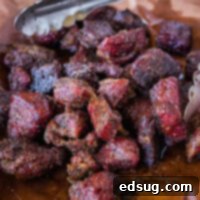
Poor Man’s Burnt Ends
Pin Recipe
Rate Recipe
Print Recipe
Ingredients
- 3-4 pound chuck roast
- 1 Tablespoon kosher salt
- 1 Tablespoon coarse black pepper
- 1 teaspoon garlic powder
- 1 cup beef broth
- 4 Tablespoons butter
- Barbecue Sauce
Instructions
-
Preheat smoker to 250º F (120ºC).
-
Cut the chuck roast into about 1 to 1.5 inch sized cubes. You want to ensure they are all the same size, so they cook evenly.3-4 pound chuck roast
-
Toss the chuck roast cubes with the salt, pepper, and garlic powder, ensuring all sides are well coated.1 Tablespoon kosher salt, 1 Tablespoon coarse black pepper, 1 teaspoon garlic powder
-
Arrange on smoker grates, leaving space between each cube, and cook at 250º F (120ºC) until they reach an internal temperature of 175º F (79ºC). This takes approximately 2 hours.
-
Every 30 minutes during the initial cook time, spray the beef cubes with beef broth to prevent drying and aid bark formation.1 cup beef broth
-
After the meat reaches 175º F (79ºC), remove it from the smoker and wrap tightly in butcher paper or foil. Add 4 Tablespoons of butter pats over the top of the meat before sealing and place back on the smoker.4 Tablespoons butter
-
Continue to cook for about another 90 minutes, or until the meat reaches an internal temperature of 205º F (96ºC) and is probe-tender.
-
Remove from the smoker and allow the wrapped meat to rest for 15 minutes to redistribute juices. Then, unwrap and toss with barbecue sauce to serve immediately.Barbecue Sauce
Nutrition
Nutrition information is automatically calculated, so should only be used as an approximation.
Additional Info
Like this recipe? Leave a comment below!
I created a fun group on Facebook, and I would love for you to join us! It’s a place where you can share YOUR favorite recipes, ask questions, and see what’s new at Dinners, Dishes and Desserts (so that you never miss a new recipe)! We love building a community around delicious food, and your contributions and questions are always welcome – come and be a part of our culinary family!
Be sure to follow me on Instagram and tag #dinnersdishes so I can see all the wonderful DINNERS, DISHES, AND DESSERTS recipes YOU make! I absolutely love seeing your culinary creations and connecting with fellow food lovers from all over the world.
Don’t miss out on any delicious updates, new recipes, or exciting cooking tips! Be sure to follow me on my social media channels to stay connected and never miss a post:
Facebook | Twitter | Pinterest | Instagram
